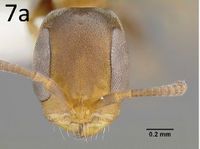Pseudomyrmex obtusus
| Pseudomyrmex obtusus | |
|---|---|

| |
| Scientific classification | |
| Kingdom: | Animalia |
| Phylum: | Arthropoda |
| Class: | Insecta |
| Order: | Hymenoptera |
| Family: | Formicidae |
| Subfamily: | Pseudomyrmecinae |
| Genus: | Pseudomyrmex |
| Species group: | goeldii |
| Species: | P. obtusus |
| Binomial name | |
| Pseudomyrmex obtusus Ward, 2017 | |
P. obtusus is known from scattered collections from Costa Rica to Peru and Brazil. Collections with habitat information come from rainforest, rainforest edge, and (Costa Rica) successional pasture near rainforest. I have made four nest collections: two from dead twigs of Ficus sp., one from a dead twig of a thorny vine, and one from a dead twig of an unidentified woody plant. (Ward, 2017)
Identification
Ward (2017) - Within the P. goeldii group this species is recognized by its large size (HW >0.70), broad head (CI >0.79), and dense punctulate sculpture on the front of the head. Other distinctive features are the matte appearance of most of the body and the absence of standing pilosity on the mesosoma, petiole and postpetiole.
Keys including this Species
Distribution
Distribution based on Regional Taxon Lists
Neotropical Region: Brazil, Costa Rica, French Guiana, Panama, Peru, Suriname, Venezuela (type locality).
Distribution based on AntMaps
Distribution based on AntWeb specimens
Check data from AntWeb
Countries Occupied
| Number of countries occupied by this species based on AntWiki Regional Taxon Lists. In general, fewer countries occupied indicates a narrower range, while more countries indicates a more widespread species. |

|
Estimated Abundance
| Relative abundance based on number of AntMaps records per species (this species within the purple bar). Fewer records (to the left) indicates a less abundant/encountered species while more records (to the right) indicates more abundant/encountered species. |

|
Biology
P. obtusus is known from scattered collections from Costa Rica to Peru and Brazil. Collections with habitat information come from rainforest, rainforest edge, and (Costa Rica) successional pasture near rainforest. Four nest collections: two from dead twigs of Ficus sp., one from a dead twig of a thorny vine, and one from a dead twig of an unidentified woody plant.
Castes
Nomenclature
The following information is derived from Barry Bolton's Online Catalogue of the Ants of the World.
- obtusus. Pseudomyrmex obtusus Ward, 2017: 539, fig. 7 (w.q.) VENEZUELA.
Unless otherwise noted the text for the remainder of this section is reported from the publication that includes the original description.
Description
Worker
(n = 9). HL 0.86–0.93, HW 0.71–0.78, MFC 0.007–0.013, LHT 0.48–0.54, CI 0.80– 0.85, REL 0.63–0.66, REL2 0.75–0.81, FCI 0.010–0.017, FI 0.50–0.52, PLI 0.62–0.71, PWI 0.52–0.64.
Larger species (HL 0.86–0.93, HW 0.71–0.78) with elongate eyes (REL 0.63–0.66) and with broader head than other species in the P. goeldii group (CI 0.80–0.85); masticatory margin of mandible with 5–6 teeth; palp formula 5,3; juncture between dorsal and declivitous faces of propodeum subangulate, and with conspicuous lateral tubercles; anterodorsal face of petiole ascending rapidly, often steeper than posterodorsal face. Front of head between eyes densely punctulate and opaque, becoming sparsely punctulate and shiny around the ocelli, then densely punctulate and opaque again at the posterior margin; mesosoma finely coriarious-imbricate and opaque; petiole, postpetiole and gaster with very fine dense pubescence, imparting a matte appearance. Standing pilosity very sparse, absent from mesosoma, petiole and postpetiole. Medium to dark brown, the petiole, postpetiole and most of gaster a contrasting light yellowish-brown; mandibles, frontoclypeal complex, tibiae and tarsi also lighter than most of body, the pronotum variably so.
Type Material
Holotype worker. Venezuela Barinas: 10 km WNW Santa Barbara, 280 m, 7°51ʹS, 71°16ʹW, 29 Aug 1987, ex dead twig of thorny vine, edge of second-growth rainforest, P. S. Ward PSW09027 (Museu de Zoologia da Universidade de Sao Paulo) (CASENT0794100). Paratypes. Series of workers, 3 dealate queens, same data as holotype (California Academy of Sciences, John T. Longino Collection, Museum of Comparative Zoology, Philip S. Ward Collection, University of California, Davis, National Museum of Natural History).
References
- Franco, W., Ladino, N., Delabie, J.H.C., Dejean, A., Orivel, J., Fichaux, M., Groc, S., Leponce, M., Feitosa, R.M. 2019. First checklist of the ants (Hymenoptera: Formicidae) of French Guiana. Zootaxa 4674, 509–543 (doi:10.11646/zootaxa.4674.5.2).
- Ward, P.S. 2017. A review of the Pseudomyrmex ferrugineus and Pseudomyrmex goeldii species groups: acacia-ants and relatives (Hymenoptera: Formicidae). Zootaxa 4227: 524–542 (doi: 10.11646/zootaxa.4227.4.3).
References based on Global Ant Biodiversity Informatics
- Franco W., N. Ladino, J. H. C. Delabie, A. Dejean, J. Orivel, M. Fichaux, S. Groc, M. Leponce, and R. M. Feitosa. 2019. First checklist of the ants (Hymenoptera: Formicidae) of French Guiana. Zootaxa 4674(5): 509-543.
